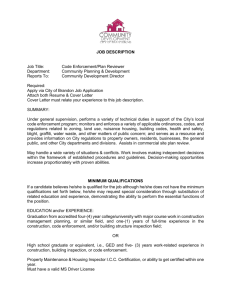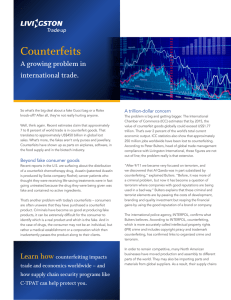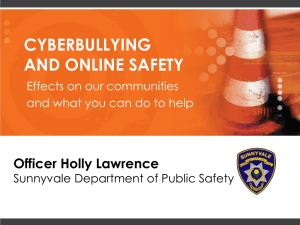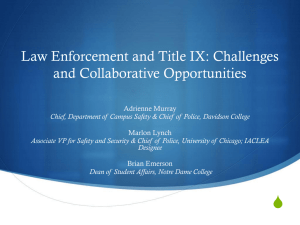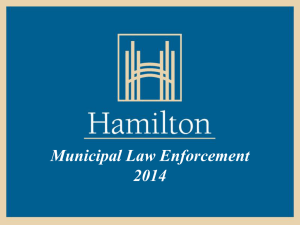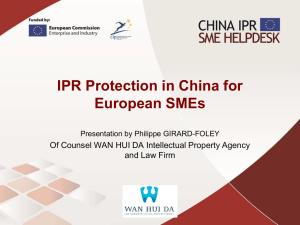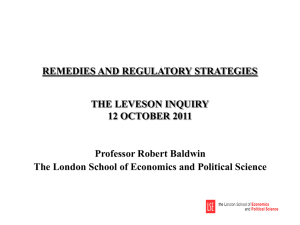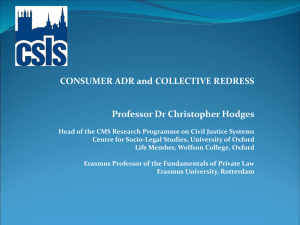Substantive Challenges In Intellectual Property
advertisement
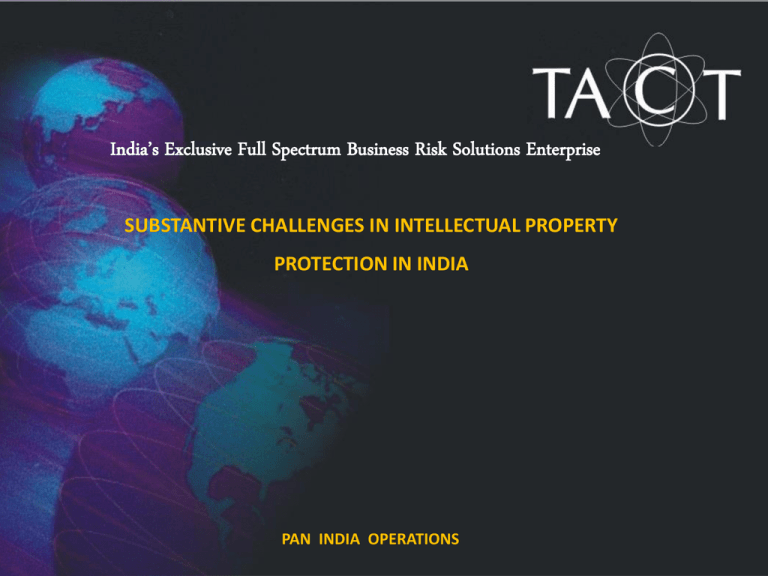
India’s Exclusive Full Spectrum Business Risk Solutions Enterprise SUBSTANTIVE CHALLENGES IN INTELLECTUAL PROPERTY PROTECTION IN INDIA PAN INDIA OPERATIONS “Enforcement has been identified as the single greatest hurdle to Intellectual Property Rights Protection in India.” ENFORCEMENT CHALLENGES The enforcement infrastructure suffers from dual challenges at both the police enforcement and judicial levels Both challenges hinge on resource prioritization The central-state division means resource prioritization and adequacy of enforcement varies from jurisdiction to jurisdiction. THE ISSUE OF SUPPLY AND DEMAND OF COUNTERFEIT PRODUCTS Both imports (particularly from China) and domestic production are counterfeiting sources in the market. A thriving and growing grey market in counterfeit goods exists to supply a population eager for cheap products. Lack of public and government awareness Government as a buyer of counterfeits Research indicates minor amendments to the Trademark law needed to improve other challenges in the market. POLICE ENFORCEMENT AUTHORITIES: CHALLENGES Lack of prioritization by police authorities of commercial crimes. Quality of enforcement varies greatly from region to region. Size of enforcement action Lack of simultaneous action Multi Jurisdictional Interpretation of the law Underfunded resources and a lack of dedicated IPR enforcement unit. Police authorities rarely conduct raids based in their own investigations Section 115(4) of the Trademark Act. Lengthy wait time to action, resulting in evidence disappearing and less effective actions. Corruption and collusion Post Enforcement debriefing of infringers and follow up actions. THE COURT SYSTEM: CHALLENGES The court system is overburdened. The backlog of existing and new cases results in lengthy delays between the time a case enters the court and the time it reaches a sentence. It takes 2 – 3 years to issue a summons and 6 – 8 years to conclude. Tribunal level cases may be pending for 7 – 10 years without resolution. Not only is the process costly but evidence disappears and criminals go free in interim years. Reluctance to apply strong penalties and deterrence level sentencing IMPORTATION OF COUNTERFEITS Customs has not prioritized trademark related seizures and there is some confusion in the registration process. Resources constraints limit the number of seizures to be conducted. Document forgery. Nonmention of brand name and misrepresentation or description of goods and low examination rates. The indemnity bond for Customs actions is bureaucratic and ineffective. Seized trademark goods sometimes finds its way back into the supply chain. China represents a critical concern. Border problems are exacerbated by trade in parallel goods. Custom officials are frustrated with industry for “failure to follow-up on seized shipments in a timely manner and failure to follow-up on legal cases. DOMESTIC MANUFACTURE OF COUNTERFEITS Authorized packaging materials find their way into counterfeit distribution channels. Low cost original products being used for high quality counterfeit products. Diversion of OEM Products Ease in availability of raw ingredients and counterfeit packaging material. TRADE ISSUES Involvement of Authorized Trade Opposition from Trade Associations BRAND OWNERS ISSUES Lack of awareness about scope of the problem Clarity in objective Seriousness in approach Approach and Expectations AGENCY ISSUES Lack of bandwidth Absence of big players Still disorganized Corruption and Collusion Non availability of complainants till the end of litigation process. Brand Protection treated like a product and not a process Deliverables ROAD AHEAD “Find means to achieve a state of viable deterrence” SOME SUGGESTED COMPREHENSIVE SET OF MEASURES Market Survey. Scoping and Mapping of the extent of the Problem. Detailed Investigations. Supply Chain Integrity Audits Investigations, Surveillance and Coordination with Customs for operations against illegal imports/ exports Internet Investigations and monitoring of E – Commerce of counterfeit products. Enforcement Actions Investigations of Institutional Sales. PR and Utilization of Media. Educating the Trader Association in Key Markets. Issue of Cease and Desist letters /notices Court Orders Comprehensive Legal Establish a Toll Free Number for obtaining information regarding counterfeit products. THANK YOU Source(s) IOCC And BASCAP Study Of India’s Counterfeiting And Trademark Environment, Member Survey And Desk Research

